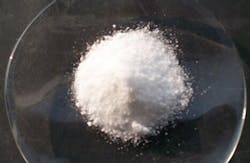Important chemical building blocks can be produced using potassium salt as a catalyst, rather than expensive precious metals, according to researchers at the California Institute of Technology (Caltech).
The new technique developed by a team of Caltech chemists uses potassium tert-butoxide, a cheap, abundant chemical, as a catalyst to help create the basis of products ranging from new medicines to advanced materials. And according to the scientists, the potassium salt is more effective than state-of-the-art precious metal complexes at running very challenging chemical reactions.
"We have shown for the first time that you can efficiently make carbon-silicon bonds with a safe and inexpensive catalyst based on potassium rather than ultrarare precious metals like platinum, palladium and iridium," commented graduate student Anton Toutov. "We're very excited because this new method is not only 'greener' and more efficient, but it is also thousands of times less expensive than what's currently out there for making useful chemical building blocks. This is a technology that the chemical industry could readily adopt."
Co-author Brian Stoltz, professor of chemistry at Caltech, explained that potassium tert-butoxide provides a straightforward and environmentally friendly way to run a reaction that involves replacing a carbon-hydrogen bond with a carbon-silicon bond to produce molecules known as organosilanes.
These organic molecules serve as chemical building blocks for medicinal chemists to use in the creation of new pharmaceuticals, Caltech reported. Not only that, they may also hold promise in the development of new materials for use in products such as LCD screens and organic solar cells, could be important in the development of new pesticides, and are being incorporated into novel medical imaging tools, the university pointed out.
"To be able to do this type of reaction, which is one of the most-studied problems in the world of chemistry, with potassium tert-butoxide — a material that's not precious-metal based but still catalytically active — was a total shocker," Stoltz said.
The new technique is described in the latest issue of the journal Nature.
